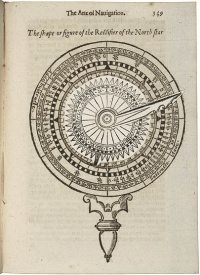The Technical Manual
Elizabeth Walsh, Head of Reader Services, and Rosalind Larry, Head of Circulation, curated The Technical Manual for The Curatorial Eye: Discoveries from the Folger Vault, one of the Exhibitions at the Folger.

Rapid developments in the fields of science and technology during the Renaissance resulted in the growth of technical how-to books, which became a popular way for skilled workers to disseminate information about their trades—from practical instructions for navigation and firefighting to directions for more whimsical (though still highly skilled) crafts such as firework displays. Printing also facilitated the inclusion of detailed illustrations which helped to explain more complex instructions to a broad spectrum of readers who possessed a wide range of reading abilities.
In his Exercises, Thomas Blundeville compiled essays on practical subjects such as mathematics, cosmology, astronomy, geography, and navigation. These exercises were specifically written for young gentlemen, especially men who were about to go off to sea. Featured to the left is a volvelle, a rotating paper or cardboard disk, which he calls a “Rectificatorium Stellae Polaris” or the “Rectifier of the North Starre,” a mechanism for pinpointing the North Star.
Cyprian Lucar was a noted author of treatises on artillery, but he also wrote essays on surveying, measurement, and estate management. In the fourth book of this treatise, Lucar writes about the uses of water, such as his “squirt” for firefighting, shown through the linked call number STC 16890. He advises that, “this kind of squirt maybe made to holde an hoggeshed of water…and may so be placed on his frame…and made to squirt out his water with great violence upon the fire that is to be quenched.”
A famous treatise on the art of glassmaking, first published in French in 1697, was translated into English in 1699. Along with detailed instructions for making glass, crystal, enamels, pearls, china, and looking-glasses, this text describes the secret for making hand-blown glass eyes so fine that “even the nicest examination can scarcely discover them to be artificial.” His method involves weaving many small, colored threads into the crystal to create the illusion of blood vessels and to attain an almost exact match of the recipient’s undamaged eye.
These technical manuals were handy for tradesmen, but also had an aspect of entertainment to them. During times of relative peace, gunner and mathematician John Babington redirected his military skill towards the design and implementation of elaborate fireworks displays, a very popular form of civic entertainment. His manual provides instruction for the manufacture of powder, the structure and placement of explosive devices, and the mathematical formulae needed to ensure the proper trajectory of the pyrotechnics, which are used to illuminate an epic struggle between a horseman and a fire-breathing dragon, shown through the linked call number STC 1099 copy 1.
Listen to Head of Circulation Rosalind Larry discuss the use and function of a Thomas Blundeville's volvelle, "Good on Paper."